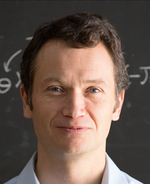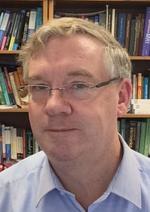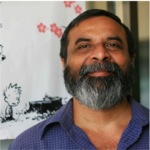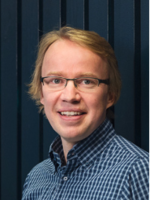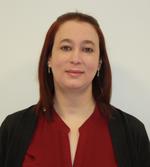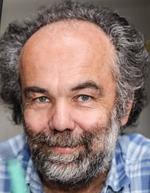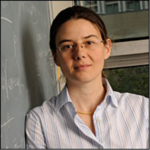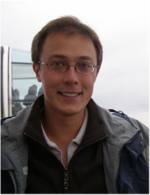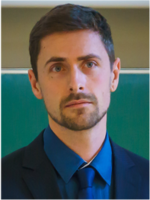This page provides information about the previous sessions of the Leipzig Spin Resonance Colloquium in spring 2021.
Leipzig Spin Resonance Colloquium Topic
Bringing together quantum simulators and machine learning: quantum assisted NMR inference
Abstract
I will review the idea of combing quantum simulators with machine learning to perform inference of NMR spectra for small biological molecules. Practical aspects of realizing this hybrid quantum-classical algorithm on currently available experimental platforms, including ion chains and Rydberg arrays, will also be discussed.
Prof. Eugene Demler
Harvard University, USA
Interactions and correlations in condensed matter systems often manifest themselves in striking and novel properties of the materials. Many examples can be found among superconductors and superfluids, quantum magnets, integer and fractional quantum Hall systems. In spite of the apparent differences among various materials and compounds, there are numerous universal phenomena that take place in interacting fermionic and bosonic systems. The main focus of Eugene Demler's work has been developing general theoretical tools for understanding the effects of interactions, and establishing a common framework for understanding the physics of strongly correlated systems. Demler's research has addressed various properties of high temperature superconductors, heavy fermion and organic superconductors, quantum Hall systems, and quantum antiferromagnets. Demler's research interests also include mesoscopic superconductivity, magnetic and superconducting proximity effects, understanding the effect of dissipation on quantum phase transitions, and Bose-Einstein condensation of alkali atoms.
For more information please visit the Matysik working group.
Faster NMR Diffusion Measurements
Abstract
NMR diffusometry (also known as Pulsed Gradient Spin-echo NMR, PGSE NMR, Diffusion Ordered Spectroscopy or DOSY) is now the method of choice for measuring translational diffusion. NMR diffusion measurements are often incorporated into MRI measurements to provide local information on diffusion. NMR diffusion measurements can report on the size of the molecule, the environment of the molecule, the geometry that the molecule is moving within (e.g., microstructure), the ordering of the environment, and molecular interactions (e.g., binding or exchange). But NMR diffusion measurements take time, typically from minutes to hours. And many samples change with time due to various types of reactions (e.g., exchange, polymerisation). To properly interpret the NMR diffusion data from such systems requires improvements in theory and/or shorter measuring times. Many methods for conducting rapid NMR diffusion measurements have been presented but most have significant limitations such as being limited to a single diffusing species or having no well-defined timescale over which the diffusion process is probed. In this lecture I will first introduce the field of NMR diffusion measurements and discuss some of its applications. I will then present various means for significantly shortening the experimental time but without any loss in accuracy and, unlike previous approaches, that are totally general in their application.
Prof. William S. Price
Nanoscale Organisation and Dynamics Group, Western Sydney University, Penrith, NSW, Australia
I am known internationally for the experimental and theoretical development of magnetic resonance techniques for measuring molecular dynamics and the application of such techniques. I have published one book (‘NMR Studies of Translational Motion’, Cambridge University Press, 2009; https://doi.org/10.1017/CBO9780511770487), 27 book chapters and 174 journal publications. My 1997 pedagogical paper on magnetic resonance diffusion measurements has been cited more than 800 times (Scopus). My work has been presented in more than 250 conference presentations including many invited and plenary lectures and lectures apart from conferences. I have an (Scopus) h-index of 34 and more than 5800 total citations. I am Editor-in-Chief of the (UK) Royal Society of Chemistry’s “New Developments in NMR” book series (https://rsc.li/nmr) – now 25 volumes. My research interests and expertise include Biological and Medical Physics, Magnetic Resonance, and Physical Chemistry: especially molecular dynamics in biological (e.g., tumours, plants) and chemical systems (e.g., azeotropes, supercooled water) using NMR imaging (i.e., MRI), NMR relaxation and NMR measurements of translational diffusion, solvent suppression, and MRI contrast agent development. My research has direct applications to a wide range of practical problems including azeotropic systems, cancer treatment, development and freezing injury in plants, pharmaceutical screening, protein association, reaction monitoring and electrolyte systems.
Echo-Based Solid-State NMR Methods for Resolution and Geometry Parameters
Abstract
Solid-state NMR spectroscopy has seen significant progress in the last several years. This has led to resolution and sensitivity enhancement and enabled extraction of geometry parameters for structural and dynamics elucidation. Much of this progress has been due to advances in magic-angle spinning and radiofrequency pulse methods. In this talk, I will focus on a subset of the methods in vogue aiming at resolution enhancement and extraction of geometry parameters. These are based on the classical spin-echo method with a judicious choice of placing the refocusing pulse. The talk will focus on the design strategies of the pulse schemes and show some of the results from model compounds.
Prof. P. K. Madhu
TIFR Centre for Interdisciplinary Sciences, TIFR Hyderabad, India
Research experience
- Development of pulse sequences for sensitivity and resolution enhancement in solid-state NMR with special emphasis to homonuclear dipolar decoupling and heteronuclear dipolar decoupling. The former enables high-resolution spectra of abundant spins, such as 1H, and the latter enables high-resolution spectra of rare spins, such as 13C. The theoretical aspects of these pulse sequences and the problem of decoupling are analysed with bimodal Floquet theory.
- Refinement of REDOR and DIPSHIFT recoupling methods enabling their application at high MAS frequencies (60-120 kHz) with low radiofrequency amplitude pulse irradiation.
- Understanding of the structural properties of oligomers of A40 and A42 peptides and conformational changes as they transit to fibrils.
- Spin-exchange optical pumping and magnetometry with hyperpolarisation and making use of concepts of weak measurement.
- Design of pulse methods for effcient spin locking of half-integer spin quadrupolar nuclei.
Ultrafast Laplace NMR
Abstract
Relaxation and diffusion NMR experiments, which are referred to Laplace NMR (LNMR), provide versatile information about molecular dynamics. The resolution and information content of LNMR can be increased by the multidimensional approach. However, long experiment time restricts the applicability of the multidimensional methods. As a solution for this problem, we are developing a broad range of ultrafast, single-scan multidimensional LNMR experiments, based on the principles of continuous spatial encoding that have been recently successfully applied in ultrafast multidimensional NMR spectroscopy. The method shortens the experimental time by one to three orders of magnitude as compared to the conventional method, offering unprecedented opportunities to study fast molecular processes in real time. Furthermore, the ultrafast approach enables using hyperpolarized substances to boost sensitivity by several orders of magnitude in the multidimensional LNMR experiments, which is not feasible in the case of traditional methods requiring extensive repetition of the experiments.
This presentation describes the basic principles and novel applications of ultrafast Laplace NMR. We have shown that the combination of ultrafast LNMR and dynamic nuclear polarization (DNP) makes it possible to distinguish intra- and extracellular metabolites in cancer cells. We have also demonstrated that the ultrafast approach is feasible also with low-field, single-sided instruments, which are portable and much cheaper than the high-field spectrometers. When combined with hyperpolarization, even single-scan experiments become viable at low fields, offering great prospects for mobile NMR analysis. Recently, we have demonstrated that ultrafast LNMR enables also single-scan 2D exchange measurements and the measurements provide unique information about exchange phenomena in the aggregates relevant in aerosol research.
Prof. Ville-Veikko Telkki
NMR Research Unit, Faculty of Science, University of Oulu, Finland
My career has focused on the development and application of advanced NMR techniques in materials research. In my PhD studies at the University of Oulu, I developed a novel method for characterization of porous materials by means of 129Xe NMR spectroscopy of xenon dissolved in a medium, called Xenon Porometry, and the work culminated in a PhD degree in physics in March 2006. From August 2005 to December 2006 I worked as a (postdoctoral) fellow in the research group of Prof. Alexander Pines in UC Berkeley, concentrating on remote detection imaging of flow of hyperpolarized fluids. Then I returned to Oulu. I have supervised the experimental NMR research group since March 2012 and redirected its research towards development and application of novel, advanced NMR and microimaging methods (such as remote detection NMR, relaxation and diffusion methods) as well as hyperpolarization techniques (PHIP and SEOP), microfluidic flow and reaction profiling, materials research (e.g., effect of thermal modification on the microstructure of wood), and biosensors. The experimental NMR group forms the NMR Research Unit together with the NMR theory group, which concentrates on the computational prediction and analysis of NMR parameters by quantum-chemical and molecular simulation methods. The experimental activity is in a tight connection with the development of theoretical analyses and models. In 2018, I received European Research Council (ERC) Consolidator Grant (CoG) of 2.6 M€ for the Ultrafast Laplace NMR, and I was also promoted to a professor position.
Investigating Disorder in Solids using NMR Spectroscopy, Isotopic Enrichment and First-Principles Calculations
Abstract
NMR spectroscopy provides an element-specific, sensitive probe of the local environment, enabling detailed information to be extracted. However, in the solid state the vast majority of this information remains unexploited, owing to the challenges associated with obtaining high-resolution spectra with good sensivity and the ease with which these can be interpreted. Recent advances enabling accurate and efficient calculation of NMR parameters in periodic systems have revolutionized the application of such approaches in solid-state NMR spectroscopy, particularly among experimentalists. Improvements in sensitivity can be obtained in a number of ways, but for nuclei with low natural abundance isotopic enrichment is a key approach. However, the high cost of enriched reagents often means that new cost-effective and atom-efficient synthetic approaches are required. Many of the interesting physical and chemical properties of materials result from a deviation of the periodic and translational symmetry characteristic of the solid state, i.e., compositional, positional or temporal disorder. Although diffraction produces an average structural picture in these cases, the sensitivity of NMR to the atomic-scale environment provides a potentially powerful tool for studying disordered materials, and the combination of experiment with first-principles calculations offers a particularly attractive approach. In this talk I will give a brief overview of solid-state NMR spectroscopy, and the approaches used to improve resolution, sensitivity and the extraction of chemical information. I will illustrate this with examples for our work on O NMR spectroscopy of microporous materials (where isotopic enrichment is vital to overcome to 0.037% natural abundance), and show how we have combined calculation and experiment to investigate disorder in phosphate frameworks and ceramic materials proposed for the encapsulation of radioactive waste.
Prof. Sharon Ashbrook
University of St. Andrews, UK
Sharon Ashbrook is a Professor of Physical Chemistry at the University of St Andrews UK. Following a DPhil at the University of Oxford. (2001), she completed postdoctoral work at the University of Exeter, before being awarded a Royal Society Dorothy Hodgkin Fellowship in 2003 which she held at the Department of Earth Sciences, University of Cambridge. During this time she also held the Charles and Katherine Darwin Research Fellowship at Darwin College. From October 2005, she was appointed as an RCUK Academic Fellow in the School of Chemistry at the University of St Andrews, and was promoted to Reader in 2009 and Professor in 2013. Her research concerns the application of NMR spectroscopy and first-principles calculations to investigate structure, disorder and chemical reactivity in inorganic solids, and she has published over 190 papers in this area. She was awarded the RSC Harrison Prize (2004), Marlow Award (2011), the RSE MakDougall Brisbane Medal (2012) and the RSC Corday Morgan Prize. She is an elected Fellow of the Royal Society of Edinburgh (FRSE), and held a Royal Society Wolfson Merit Award. She has an interest in outreach (and is Chair of the Tayside RSC Local section) and in the promotion of women in STEM, co-authoring booklets entitled Academic Women Now (2016) and Academic Women Here (2018). She was awarded a Suffrage Science Award in 2017.
Hybrid magnetic resonance of individual spins in diamond NV centers
Abstract
Magnetic resonance is generally acknowledged for its universality and its high information content. One of the main limitations is its limited sensitivity, although this has improved greatly over time, reaching the ultimate limit with experiments on individual spins - electronic as well as nuclear ones. The systems that allow such experiments include molecular as well as inorganic systems. A particularly popular case is the nitrogen-vacancy (NV) center in diamond, which consists of an electronic spin S=1 and nuclear spins 14N and 13C. This system has interesting properties for many applications in emerging quantum technologies like sensing, communication and information processing. In addition, the interactions between the spins also allow detailed studies of fundamental effects of magnetic resonance, such as enhanced nuclear magnetism or nonlinear dynamics.
Prof. Dieter Suter
Technische Universität Dortmund, Germany
Fields of interest
- Development of advanced magnetic resonance techniques
- Optically enhanced magnetic resonance
- Quantum information processing, quantum simulation and quantum sensing
- Medical physics applications of magnetic resonance
Hyperpolarized 129-Xe MRI: Past, Present, and Future
Abstract
MRI using hyperpolarized noble gases was introduced in 1994, and while showing extraordinary promise, has experienced a tortuous clinical development pathway. Although the elegance of acquiring rapid and non-invasive 3D images of an inhaled, noble gas, captivated many scientists and clinicians from the outset, its widespread clinical dissemination has been slower than might have been expected. Some of the impediment was readily attributed to barriers associated with intellectual property rights, poor corporate stewardship, and a challenging regulatory environment. Fortunately, these issues have now largely been addressed and with continued technical development 129Xe MRI is poised for FDA approval. This would make it the first approved drug/device combination that uses multi-nuclear MRI. With this progress we are now in a position to exploit the solubility and chemical shift properties that make 129Xe so uniquely suited to imaging pulmonary gas exchange, the most fundamental function of the lung. In this talk, I will review the history of hyperpolarized 129Xe development, key clinical and technical milestones, as well as the commercial and regulatory progress. Beyond these milestones, I will discuss efforts to conduct larger-scale clinical trials to demonstrate the clinical value of 129Xe MRI by improving patient management. And finally, some interesting new applications in organs beyond the lung will be discussed.
Prof. Bastiaan Driehuys
Duke University Medical Center, Durham NC, USA
My research program is focused on developing and applying hyperpolarized gases to enable fundamentally new applications in MRI. Currently we use this technology to non-invasively image pulmonary function in 3D. Hyperpolarization involves aligning nuclei to a high degree to enhance their MRI signal by 5-6 orders of magnitude. Thus, despite the low density of gases relative to water (the ordinary signal source in MRI), they can be imaged at high-resolution in a single breath. This technology leads to a host of interesting areas of study including: investigating the basic physics of hyperpolarization, developing new MR methods and hardware for image acquisition, image analysis and quantification, and of, course applying this technology to a host of chronic diseases including, asthma, chronic obstructive pulmonary disease, and pulmonary fibrosis.
How to avoid HEATED arguments among your spins
Abstract
Quantum devices could perform some informational tasks with much better performances than classical systems, with profound implications for cryptography, chemistry, material science, and many areas of physics. However, to reach this goal we need to control large quantum systems, where the many-body dynamics becomes fragile and the system quickly heats up to its thermal state.
There are then two key questions:
How does a closed quantum system thermalize (thus losing its “quantum power”)?
How can we preserve quantum information in the presence of strong interactions?
Using a nuclear spin chain as an exemplary experimental system, and the tools of Hamiltonian engineering and nuclear magnetic resonance, I will show how to choreograph the dynamics in order to prevent the system from heating up, even in the presence of strong interactions among spins.
Among the strategies to prevent thermalization, I will focus on localization via disorder, which can quench the scrambling of quantum information, and Floquet engineering, which can induce prethermalization, a long-lived state that thermalizes only exponentially slowly.
Prof. Paola Cappellaro
Nuclear Science & Engineering Department, Physics Department
Massachusetts Institute of Technology, Cambridge, MA 02139, USA
Paola Cappellaro is Professor of Nuclear Science and Engineering at the Massachusetts Institute of Technology and a member of the Research Lab for Electronics, where she leads the Quantum Engineering Group. She received her Ph.D in 2006 from MIT and she then joined Harvard University as a postdoctoral associate in the Institute for Theoretical Atomic, Molecular and Optical Physics (ITAMP), before going back to MIT as a faculty in 2009.
Prof. Cappellaro is an expert in NMR, ESR, coherent control and quantum information science. She is a specialist in spin-based quantum information processing and precision measurements in the solid state. With collaborators, she developed the concept and first demonstrations of NV-diamond magnetometers. Cappellaro's major contributions have been in developing control techniques for nuclear and electronic spin qubits, including NV-diamond, inspired by NMR techniques and quantum information ideas. The goal is the realization of practical quantum nano-devices, such as sensors and simulators, more powerful than their classical counterparts, as well as the acquisition of a deeper knowledge of quantum systems and their environment. Her work has been recently recognized by the Young Investigator Award from the Air Force Office of Scientific Research and a Merkator Fellowship.
Training and reverse-engineering neural nets on magnetic resonance
Abstract
The signalling between inner layers of fully connected neural networks is scrambled because back-propagation training does not require perceptrons to be arranged in any particular order. The input and the output inherit the order from the training database, but all internal signalling has the appearance of noise. The resulting lack of interpretability and trust is a much criticised feature of deep neural networks.
We recently found a group-theoretical procedure that brings the intermediate signalling into a human-readable form. Applied to magnetic resonance data processing networks, the method revealed unexpected internal sophistication: our networks spontaneously invented bandpass filters, notch filters, frequency axis rectifiers, frequency division multiplexing, spectral filtering regularisation, and a Fourier-like transform that maps harmonic functions into Chebyshev polynomials.
Prof. Ilya Kuprov
University of Southampton, UK
The Nitrogen Vacancy Center in Diamond as Source for Nuclear Hyperpolarization
Abstract
Nuclear magnetic resonance (NMR) is a powerful method with high spectral resolution and is therefore widely used in physics and chemistry, for example in the structural analysis of molecules. Furthermore, magnetic resonance imaging (MRI) is a crucial tool in modern medical diagnostics today. The signal intensity in these applications is largely determined by the polarization of the spins involved, i.e. by the different occupation of the spin energy levels. In thermal equilibrium, the occupation of the energy levels is described by the Boltzmann distribution. Since the energy levels are energetically close to each other, there is only a small difference in the population at room temperature and thus only a weak signal intensity. For example, 13C spins (I=1/2) in a magnetic field of 7 T at room temperature yield only a polarization of ~10-5. In order to improve the NMR signal intensity it is usually tried to increase the polarization by low temperatures or high magnetic fields.
In recent years, the idea of employing negatively charged nitrogen vacancy (NV) centers (S=1) in diamond as polarization agents for nuclear spins is attracting increasing interest because its electron spin can be almost completely polarized by illumination with green light. The talk will cover an introduction to the outstanding properties of NV centers, their generation, and finally their application in NMR as polarization source.
Dr. Ralf Wunderlich
Leipzig University, Germany
Ralf Wunderlich's main research interest is in defect centers in solids - in particular the nitrogen vacancy (NV) center in diamond and its interaction with its spin environment. His work can be characterized as a combination of expertise from different fields to develop new approaches for the application of fundamental physics research. Herus uses a wide range of methods, such as ion beam techniques, confocal microscopy, optical detected magnetic resonance (ODMR), nuclear magnetic resonance (NMR) and also numerical calculations.
Magnetic Resonance Imaging at High Magnetic Fields – Biomedical Research Potential of 7 Tesla and Higher
Abstract
Over the past four decades, magnetic resonance imaging (MRI) and spectroscopy in humans have emerged as vital tools for clinical diagnosis and basic life science research including cognitive neuroimaging. Although MRI provides exceptional contrast in the soft tissues of the body and does not utilize any ionizing radiation, so that examinations can be repeated without concern of unintended tissue damage, it is highly constrained by limited sensitivity, leading to either suboptimal spatial resolution or extended examination times. An ongoing trend since the introduction of MRI has thus been magnets with more powerful static magnetic fields. The latest magnetic field strength that has been approved for medical diagnosis is 7 Tesla (300 MHz proton resonant frequency). Although the high magnetic field provides gains in signal-to-noise or contrast-to-noise ratio, allowing finer structures to be visualized and smaller physiological effects to be detected, imaginghuman-sized objects at such high frequencies presents several challenges including non-uniform radiofrequency fields, enhanced susceptibility artifacts, and higher radiofrequency energy deposition in the tissue. In this presentation, I will take a look at the state-of-the-art of human biomedical imaging at 7 Tesla. I will also look at the perspective for going to even higher magnetic fields, including both physical/engineering challenges as well as some relevant physiological considerations of human exposure to high fields. Human research magnets at 9.4 or 10.5 Tesla are already operational, with 11.7 Tesla expected in the near future, and several international consortia are planning the establishment of human MRI systems at 14 Tesla.
Prof. Mark E. Ladd
DKFZ, Heidelberg, Germany
